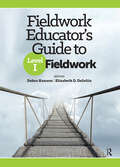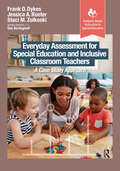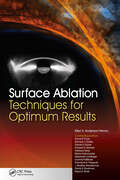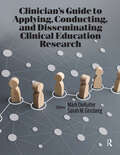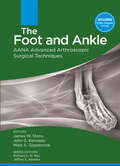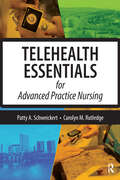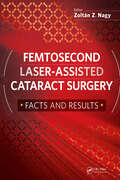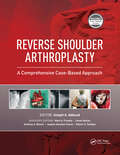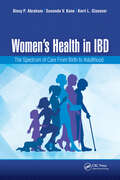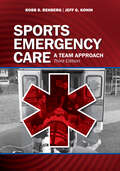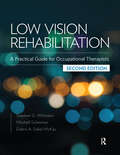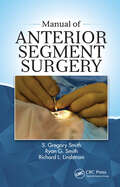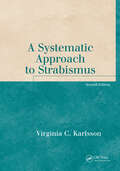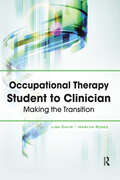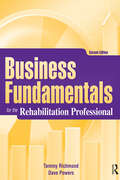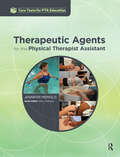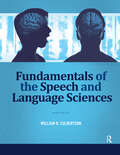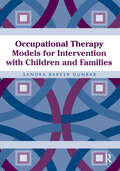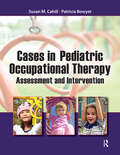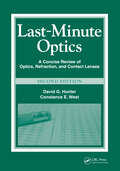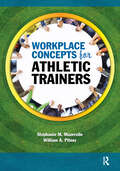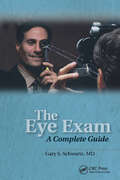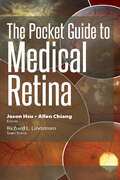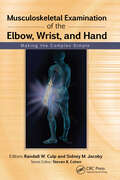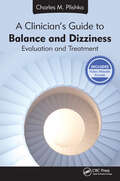- Table View
- List View
Fieldwork Educator’s Guide to Level I Fieldwork
by Debra Hanson Elizabeth DeIuliisA new resource for occupational therapy academic fieldwork coordinators and fieldwork educators, Fieldwork Educator’s Guide to Level I Fieldwork is a practical guide for faculty and clinicians to design and implement Level I fieldwork experiences for occupational therapy and occupational therapy assistant students.Fieldwork Educator’s Guide to Level I Fieldwork was designed to address the challenges of integrating Level I fieldwork with classroom learning experiences. Expansive and versatile, the book meets the recently expanded definition of Level I fieldwork according to the 2018 Accreditation Council for Occupational Therapy Education standards, including faculty-led experiences, standardized patients, simulation, and supervision by a fieldwork educator in a practice environment.Each unit of the text builds upon the previous unit. The first unit provides fundamental knowledge on experiential learning and includes an orientation to the purpose of Level I fieldwork in occupational therapy. Building on this foundation, the second unit equips the reader with resources to develop a Level I fieldwork learning plan suitable for their setting. The final units focus on situational scenarios that emerge during Level I fieldwork placements and provides a framework for assessing student learning during Level I fieldwork. While each chapter is designed to build upon one another, they also can be used as stand-alone resources depending on the needs of the reader.What is included in Fieldwork Educator’s Guide to Level I Fieldwork: Up-to-date terminology Experiential learning frameworks and models in diverse contexts, including role emerging and simulation Strategies for addressing anxiety and student stress management and supporting students with disabilities Models to support clinical reasoning development during Level I fieldwork Mechanisms to foster student professional development and communication skills Be sure to also look into the successive textbook, Fieldwork Educator’s Guide to Level II Fieldwork, which was designed in-tandem with this book to be a progressive resource that exclusively focuses on Level II fieldwork.
Everyday Assessment for Special Education and Inclusive Classroom Teachers: A Case Study Approach (Evidence-Based Instruction in Special Education)
by Frank Dykes Jessica Rueter Staci ZolkoskiEveryday Assessment for Special Education and Inclusive Classroom Teachers: A Case Study Approach provides a foundation in practical research-based methods to help today’s teachers tailor their instruction to meet the needs of all learners.With an easy-to-understand format, Everyday Assessment for Special Education and Inclusive Classroom Teachers combines real-life case studies with practitioner-friendly wording to teach and describe assessment topics in a concise manner. Practical applications for use in classroom settings can also be found throughout the text.What’s included in Everyday Assessment for Special Education and Inclusive Classroom Teachers: Example progress monitoring charts Curriculum-based assessments, behavior charts, and norm-referenced assessments to guide the reader when extracting data and inform everyday teaching practices Activities to practice skills and self-reflect on learning objectives at the end of each chapter Everyday Assessment for Special Education and Inclusive Classroom Teachers: A Case Study Approach pairs rationale and research with real-life case studies and applications for practice to prepare pre-service teachers to meet the unique needs of every learner.
Surface Ablation: Techniques for Optimum Results
by Ellen PennoWith Surface Ablation: Techniques for Optimum Results, refractive surgeons will learn efficient pre- and post-op routines that optimize chair time and lead to improved safety and excellent results for patients. Inside Surface Ablation: Techniques for Optimum Results by Dr. Ellen Anderson Penno is joined by 9 contributors who offer a practical approach with clinically useful tips including patient counseling and post-operative care that will improve patient satisfaction. This up-to-date book is an excellent resource for patient assessment of candidacy for refractive surgery or in post-operative co-management. In addition to chapters with information on patient selection, surgical techniques, post-op care, and prevention and management of complications, Surface Ablation: Techniques for Optimum Results includes several articles, contributed by leaders in the refractive surgery field, covering a variety of topics including surface ablation in keratoconus patients, corneal cross-linking, and ectasia. Surface Ablation: Techniques for Optimum Results is a clinically-oriented resource for residents and new refractive surgeons as well as the many seasoned refractive surgeons, general ophthalmologists following the increasing trend of transitioning away from LASIK towards surface ablation for many of their patients.
Clinician’s Guide to Applying, Conducting, and Disseminating Clinical Education Research
by Mark DeRuiter Sarah GinsbergClinician's Guide to Applying, Conducting, and Disseminating Clinical Education Research provides clinical educators with the fundamental knowledge to be effective consumers of research and integrate it into their clinical education practice.Clinical educators are routinely called upon to provide early-career clinicians with clinical education and supervision within their practice. Clinician’s Guide to Applying, Conducting, and Disseminating Clinical Education Research fits at the intersection of clinical education and research for the supervising clinician—helping clinicians consider how they might contribute to the scholarship of teaching and learning related to clinical education.This one-of-a-kind text features a multidisciplinary perspective with contributors from various fields in allied health, such as speech-language pathology, occupational therapy, audiology, physical therapy, and more.What’s included in Clinician’s Guide to Applying, Conducting, and Disseminating Clinical Education Research: A hands-on workbook section for clinical educators to apply the content to education and clinical supervision research Chapters on seeking research mentorship, qualitative and quantitative research foundational concepts, and publishing and presenting research Parallels between evidence-based practice and evidence-based education Clinician’s Guide to Applying, Conducting, and Disseminating Clinical Education Research walks the reader through generating research all the way to implementation and dissemination while linking communities of working professionals to their students and research institutions.
The Foot and Ankle: AANA Advanced Arthroscopic Surgical Techniques (AANA Advanced Arthroscopic Techniques series)
by James Stone Mark Glazebrook Kennedy JohnCo-published with the Arthroscopy Association of North America, The Foot and Ankle: AANA Advanced Arthroscopic Surgical Techniques is a comprehensive technique-based book that presents the latest diagnostic and reconstructive techniques in arthroscopic surgery for the foot and ankle. The Foot and Ankle: AANA Advanced Arthroscopic Surgical Techniques is authored by premier arthroscopic surgeons Drs. James W. Stone, John G. Kennedy, and Mark Glazebook, and their international list of expert contributors. This comprehensive resource includes preferred physical examination testing and diagnostic imaging choices in pre-operative planning and patient selection, state-of-the-art step-by-step description of the procedures, detailed surgical equipment lists to perform each procedure, clear and precise indications for surgery and the thoughtful rationale behind stated contraindications, controversial indications, post-operative protocols, and potential complications. The written text is supported by numerous color images and a website with invaluable, narrated video clips depicting disease-specific arthroscopic techniques specific to the foot and ankle. Features inside The Foot and Ankle: AANA Advanced Arthroscopic Surgical Techniques Narrated video accompanies all surgical techniques, focusing on the stepwise approach to each operation Consistent organization throughout the book results in a bulleted and user-friendly interface for a quick reference or prolonged study Top 5 Technical Pearls for each procedure to enhance outcomes and to avoid common pitfalls and complications High-quality artwork and figures to compliment clinical images Equipment and surgical technique checklists for quick reference prior to surgery Each expert contributor was chosen for his or her expertise for a specific topic related to The Foot and Ankle, so the reader benefits by the highest quality and treatment recommendations to provide state-of-the-art care to his or her patient.Some chapter topics include:-Reconstruction Using Allograft and Autograft-Lateral Approach to Subtalar Arthroscopy-Achilles Tendinopathy-Chondral Defects of the First MTP Joint-Matrix-Induced Autologous Chondrocyte Implantation
Telehealth Essentials for Advanced Practice Nursing
by Patricia Schweickert Carolyn RutledgeA timely, practical, and concise resource for advanced practice registered nursing (APRN) students, faculty, and providers, Telehealth Essentials for Advanced Practice Nursing provides readers with an understanding of and tools to embrace the emerging field of telehealth and optimize its application in clinical practice. Telehealth offers a unique solution to many health-care challenges, such as provider shortages, chronic disease management, an aging population, protection from infectious disease, and limited access to care. As telehealth is being incorporated into health care and health care delivery at an ever-increasing rate, APRNs that can navigate the telehealth arena are uniquely positioned to serve as leaders in the health care of the future. Using Telehealth Essentials for Advanced Practice Nursing, readers will learn how to utilize telehealth to provide new and innovative methods of care.Authors Patty A. Schweickert and Carolyn M. Rutledge present a multi-modal approach to telehealth education that layers telehealth onto nurses’ existing knowledge of nursing practice. The text begins with the history and basics of telehealth before moving on to critical content that a provider must understand to maximize its use in the health care arena, covering topics including: Technology used in the early response to infectious diseases such as COVID-19 The process of integrating telehealth in practice Laws, policies, and regulations governing telehealth practice Barriers to implementation and strategies for overcoming them Telehealth etiquette and ethics Using telehealth for effective interprofessional collaboration Each chapter includes group exercises, prompts for reflection, questions for discussion, and case studies. Included with the text are online supplemental materials for faculty use in the classroom.With Telehealth Essentials for Advanced Practice Nursing, APRN students, faculty, and practicing providers will learn to advocate for telehealth implementation, establish telehealth programs, and utilize telehealth to overcome barriers to care in order to optimize access and quality of care.
Femtosecond Laser-Assisted Cataract Surgery: Facts and Results
by Zoltan NagyDr. Zoltan Z. Nagy performed the first femtosecond laser-assisted cataract surgery in a human eye in 2008. As one of the most authoritative sources on the topic, Femtosecond Laser-Assisted Cataract Surgery: Facts and Results presents the history of the development and use of femtosecond laser-assisted cataract surgery summarizes the results of five years of pioneering techniques by Dr. Nagy and his team, including personal reflections and thoughts, as well as a series of classic papers.Femtosecond Laser-Assisted Cataract Surgery consists of two main sections. The first section discusses and reviews the new results for the reader from the research. The second section comprises original articles on the topic of femtosecond laser cataract surgery that is essential to ophthalmologists.Additional features include:• A review of the current state-of-the-art usages of femtosecond laser-assisted cataract surgery• Examine existing technologies that compete with femtosecond laser-assisted cataract surgery and compare outcomes• Discuss key secrets to successful surgical techniques using femtosecond laser-assisted cataract surgery• How to address and manage common complications associated with femtosecond laser-assisted cataract surgeryFemtosecond Laser-Assisted Cataract Surgery presents these clinical results with cataract and corneal application, and highlights basic research with the strength of the anterior capsule and will assist ophthalmologists and residents alike gain a better understanding of the femtosecond laser cataract surgery process.
Reverse Shoulder Arthroplasty: A Comprehensive Case-Based Approach
by Joseph AbboudFocused on the rapidly expanding field of reverse shoulder arthroplasty, Reverse Shoulder Arthroplasty: A Comprehensive Case-Based Approach is a detailed guide for shoulder surgeons. As this type of arthroplasty continues to grow globally, this text fills the need for a comprehensive and current book on this topic. This text is edited by Dr. Joseph Abboud, alongside co-editors Drs. Frankle, Romeo, Sanchez-Sotelo, Neyton, and Tashjian. With dozens of leading orthopedic shoulder surgeons as contributors, Reverse Shoulder Arthroplasty: A Comprehensive Case-Based Approach serves the needs of a broad audience of surgeons. This includes fellowship-trained shoulder surgeons, sports surgeons, generalists, traumatologists, hand surgeons, and orthopedic oncologists. The unique, case-based approach highlights the current and historic principles of reverse shoulder arthroplasty. Important featured topics in Reverse Shoulder Arthroplasty include: Relevant anatomy, indications, and surgical approaches Theory of design and its practical applications: materials used, base plate design, glenospheres, and humeral stems Primary reverse shoulder arthroplasty: RSA for several different indications, how experts perform the operation, and techniques utilized in certain cases Revision reverse shoulder arthroplasty: step-by-step approach, evaluation of infection, instability, managing bone loss, and more Miscellaneous topics: various approaches to rehabilitation, salvage options, and non-arthroplasty options for the rotator cuff deficient shoulder Video website access is included with purchase, providing additional audio-visual support to theories and principles discussed in each chapter by the world’s leading experts.Reverse Shoulder Arthroplasty: A Comprehensive Case-Based Approach is a comprehensive and current guide intended to assist all levels of shoulder surgeons. This go-to resource will be a foundational asset to any surgeon in this expanding field.
Women's Health in IBD: The Spectrum of Care from Birth to Adulthood
by Sunanda V. Kane Bincy P. Abraham Kerri L. GlassnerA comprehensive guide, Women’s Health in IBD: The Spectrum of Care From Birth to Adulthood will help providers approach the specific issues that women with inflammatory bowel disease (IBD) face throughout their lifetimes. This book will better equip providers to counsel and support women of all ages with IBD.In Women's Health in IBD, Drs. Bincy P. Abraham, Sunanda V. Kane, and Kerri L. Glassner focus on the unique aspects of care for women with IBD. Half of the IBD patient population is female. As we understand more about gender and sex differences in terms of genetics, physiology, and medical care, it is important to consider these factors between men and women to personalize their care.This book encompasses the entire life span of the female IBD patient through birth, adolescence, pregnancy, menopause, and older adult years. Each chapter includes discussions of medications, treatment plans, and common questions or controversies on important topics in IBD such as: Transitioning from pediatric to adult care Diet and nutrition Mental health Health maintenance Family planning Pregnancy and breastfeeding Menopause Concomitant irritable bowel syndrome Women’s Health in IBD: The Spectrum of Care From Birth to Adulthood is an essential text that will help anyone who treats women with IBD, offering practical tools and takeaways for point of care and beyond.
Sports Emergency Care: A Team Approach
by Jeff G. Konin Robb RehbergFor more than a decade, Sports Emergency Care: A Team Approach has filled a void in athletic training education on the subject of emergency care. Now, this updated Third Edition continues to pave the way to prepare athletic training students beyond traditional first aid training as well as providing specific information on emergency situations in sports for emergency medical services (EMS) professionals. In this updated Third Edition, Dr. Robb S. Rehberg and Dr. Jeff G. Konin, along with their 13 contributors, have created a resource that can be used in athletic training education programs as a core text in a sports emergency care course; a supplemental text in several courses that address immediate care within an athletic training education curriculum; and it can be used by EMS educators in developing continuing education programs for prehospital providers. Some of the topics included in the Third Edition: Assessment of Sports Emergencies Cardiovascular Emergencies Management of Traumatic Brain Injury Fractures and Soft Tissue Injuries Managing Mental Health Emergencies Care of Athletes with Disabilities Emergencies in Sports for the Aging Athlete Regardless of discipline, it is important for all health care providers caring for ill or injured athletes to be knowledgeable and proficient in managing sports emergencies. This ability can only be achieved through preparation and practice, and Sports Emergency Care: A Team Approach, Third Edition continues to be a groundbreaking text that gives access to the essential resources health care providers need to address sports emergencies. This includes but is not limited to athletic trainers, emergency medical technicians and paramedics, and physicians.From the Foreword: “Emergencies can occur anytime and anywhere in sports, including at a practice or on the bus traveling to an event. After nearly 40 years as a professional sports athletic trainer, these emergency moments give me pause. Preparation is the key to successful outcomes in all emergencies.” —Ronnie P. Barnes, MS, ATC Senior Vice President, Medical Services Head Athletic Trainer New York Football Giants
Low Vision Rehabilitation: A Practical Guide for Occupational Therapists
by Mitchell Scheiman Stephen Whittaker Debra Sokol-McKayThis Second Edition of Low Vision Rehabilitation: A Practical Guide for Occupational Therapists provides current, evidence-based information on low vision rehabilitation that contains several new and expanded chapters on ADLs, IADLs, and recreation, as well as new online resources and the latest in accessibility devices.Low vision rehabilitation is rapidly growing as a specialty practice for occupational therapists. This growth requires practical, evidence-based information on the evaluation and treatment of the effects of low vision on occupational performance. Responding to this need, Low Vision Rehabilitation: A Practical Guide for Occupational Therapists, Second Edition blends standards of practice that have been developed for over 50 years by low vision therapists and optometrists, with the latest scientific research and the unique perspective of occupational therapists.This text is written to introduce the student and general practitioner to low vision rehabilitation as commonly encountered in medical rehabilitation as well as provides a conceptual approach to evaluation and treatment that will enrich an advanced practice. Authors Stephen Whittaker, a low vision researcher, certified low vision therapist and occupational therapist, Mitchell Scheiman, an optometrist and researcher, and Debra Sokol-McKay, an occupational therapist with specialty certification in low vision as well as certification as a low vision therapist, vision rehabilitation therapist and diabetes educator, have carefully selected evidence-based evaluations and treatments that focus on clinical practicality and meaningful occupational goals in adults.New to the Second Edition: A focus on occupational performance using “whatever works,” whether visual, non-visual, or a combination of these different devices and adaptive techniques The “EPIC” Framework, a general strategy to organize a treatment plan for daily activities using visual and non-visual techniques Access to a companion website designed as a handy clinical reference, with solutions to clinical problems easily searchable and cross-linked to related content The “Success-Oriented Approach” to interventions based on the most recent research on cognitive disability and depression associated with low vision Applications of the latest electronic accessibility devices including smartphones, tablets, and magnifiers that read aloud Incorporates the AADE™ 7 Self-Care Behavior framework of the American Association of Diabetes Educators Incorporates concepts from the latest edition of the AOTA Occupational Therapy Practice Framework: Domain and Process A chapter devoted to field loss, spatial neglect and perceptual impairments resulting from acquired-brain-injury. The latest in Medicare documentation standards including outcome to G-code conversions and ICD-10 diagnostic coding for low vision. Included with the text are online supplemental materials for faculty use in the classroom.Features Included: Recommended practical evaluation and treatment methods such as a 1 hour evaluation protocol, how to write observable and measurable goals and document outcomes, and specific instructions on how to implement treatments Prepares therapists for the ACVREP certification as a low vision therapist or vision rehabilitation or AOTA specialty certification in low vision Emphasizes intervention and low vision rehabilitation treatment including: modification of the environment adaptive visual and non-visual techniques selection and use of non-optical assistive devices selection and use of electronic and optical devices and use of computer technology including smartphones and tablets Comprehensive case studies on vision impairment resulting from eye disease to head injury and more Provides valuable in
Manual of Anterior Segment Surgery
by S Gregory Smith Ryan Smith Richard LindstromMicroscopic surgery requires complicated maneuvers. There are often photos, videos, and descriptions of what the instruments are doing. However, there are ways to set yourself up for success in ophthalmic surgical techniques. Inside the Manual of Anterior Segment Surgery is the wisdom of over 4 decades of surgical experience by Drs. Gregory Smith, Ryan Smith, and Richard Lindstrom covering the essentials of anterior segment surgery. Through this experience, one of the key ingredients in setting yourself up for success is the position of your hands with relation to the instrument and what you are trying to accomplish with the instrument. In a concise yet detailed manner, the basics of microscope management, patient head position, surgeon hand position, the relationship of the instrument and the hands, and how to enhance the performance of every surgical maneuver are covered with helpful illustrations. Designed to enhance your surgical techniques by putting you in a position to succeed, this manual will show you how to make the complex maneuvers look simple and improve patient outcomes. The Manual of Anterior Segment Surgery is a method to shorten your timeline to excellent surgery
A Systematic Approach to Strabismus (The Basic Bookshelf for Eyecare Professionals)
by Virginia KarlssonWritten for the true beginner, the updated and revised second edition of A Systematic Approach to Strabismus examines the basic types of strabismus, ocular motility, ocular examination of pediatric patients, and extraocular muscle anatomy and functions.Unique features inside the Second Edition: Uses practical and easy-to-follow “how to” instructions to offer fundamental education on the four parts of an eye exam: history, vision, sensory testing, and motor testing Includes necessary information to successfully complete pediatric and strabismus eye exams Highlights the order of testing in an effort to gather the most important information prior to a pediatric meltdown and to avoid "exam pollution" Having worked in both private practice and university settings, Virginia Karlsson brings over 30 years of experience with pediatric ophthalmology and adult strabismus to the pages of A Systematic Approach to Strabismus, Second Edition. Ophthalmic technologists, technicians, assistants, residents, and students will welcome this unique book into their education and career.
Occupational Therapy Student to Clinician: Making the Transition
by Lisa Davis Marilyn RoseeIt is surprising that there is no “go-to” resource for the occupational therapy or occupational therapy assistant student to have when they embark on their professional journey. With this in mind, Lisa Davis and Marilyn Rosee have written Occupational Therapy Student to Clinician: Making the Transitionto help students hone the skills employers look for in new hires. While many academic programs cover career-oriented topics, this is the first specific text to pull the pieces together with the purpose of showing readers how to become successful job candidates and employees. Perfect for the student preparing for an occupational therapy career, Occupational Therapy Student to Clinician covers all pragmatic issues that students face while securing their first job. This text outlines a variety of topics including résumé writing, interview skills, negotiating a salary, working within a team, developing professional competencies, and understanding the culture of an organization. Each chapter includes learning objectives and lists of practice activities that students can use to reinforce their skills.Occupational Therapy Student to Clinician: Making the Transition will benefit occupational therapy and occupational therapy assistant students preparing to graduate, as well as employed clinicians dealing with specific employment-related issues. This text will also guide the employee who wants to move to the next job and reacquaint themselves with the job-seeking process. This comprehensive resource provides strategies and solutions for many employment challenges and will be an asset in any professional development curriculum.
Business Fundamentals for the Rehabilitation Professional
by Tammy Richmond Dave PowersThe world of business is ever changing, with much of the available information becoming quickly out-of-date. Business Fundamentals for the Rehabilitation Professional, Second Edition keeps pace with this changing world and provides the health care professional with the latest information to answer the “what, where, how, and when” questions that come up when transforming a health care practice idea into a successful business.With this updated Second Edition, Tammy Richmond and Dave Powers take the health care professional to the next level of implementing successful business operations by the introduction of applications of management principles, as well as implementation of evidence-based practice guidelines and basics to billing and coding documentation. Business Fundamentals for the Rehabilitation Professional, Second Edition addresses how to identify emerging business opportunities, legal and health care regulatory issues, market research and development, and health care operations.New features in the Second Edition: New Management and Operations checklist An in-depth look at reimbursement, billing, and financial survival Strategic target market promotions Updated templates and tools Review questions Downloadable worksheets available with text purchase Keeping the user-friendly format of a workbook, Business Fundamentals for the Rehabilitation Professional, Second Edition is the perfect resource for master and doctorate level students preparing for the professional world, as well as rehabilitation professionals and entrepreneurs interested in obtaining knowledge in starting up, managing, expanding, or understanding the health care practice system.What will you learn? How to create a vision and mission statement How to develop a business and marketing plan How to manage finances within the scope of the practice What are your local state and federal regulations What are the small business guidelines
Therapeutic Agents for the Physical Therapist Assistant (Core Texts for PTA Education)
by Jennifer MemoloThe first textbook specifically for physical therapist assistant (PTA) students on physical agent modalities, Therapeutic Agents for the Physical Therapist Assistant is a standout resource that will greatly enhance a PTA curriculum.Therapeutic Agents for the Physical Therapist Assistant focuses on the use and execution of each physical agent, covering thermal, sound-energy, mechanical, electrical, and electromagnetic agents. Tables, graphs, review questions, and photos are included for visual reference and lab practice. Clinical tips and case studies are sprinkled throughout each chapter, along with sample documentation and checklists to follow when documenting a therapeutic modality. Topics include: Thermal agents, including thermotherapy and cryotherapy Sound-energy modalities, including therapeutic ultrasound and phonophoresis Mechanical agents, including hydrotherapy, traction, compression, manual therapy, and soft-tissue mobilization Electrical agents, including electrotherapy Electromagnetic agents, including shortwave diathermy, low-level laser therapy, infrared light therapy, and ultraviolet light Included with the text are online supplemental materials for faculty use in the classroom, consisting of an Instructor’s Manual and PowerPoint slides.This textbook is perfect for instructors in PTA programs looking for a text on physical modalities and agents that is geared specifically toward their students. This text will equally hold a valuable place on the shelf as an important reference text for PTA students after they enter the field.
Fundamentals of the Speech and Language Sciences
by William CulbertsonFor a strong foundation upon which to build their futures, students in communication sciences and disorders programs need the best, most up-to-date information available to guide them. To this end, Fundamentals of the Speech and Language Sciences provides a thorough understanding of the core concepts in speech and language while maintaining a readable, engaging tone. Students will be exposed to the fundamentals of acoustics, respiratory science, voice production, acoustic phonetics, and sound spectrography. Language representation and motor programming as they pertain to the dynamic process of speech communication are also explored, as are the fundamentals of speech perception and instrumentation. To give students context, side bars feature the stories of seminal scientists and scholars and their contributions to the topics being discussed. This text benefits from Dr. William Culbertson’s nearly three decades of experience in teaching, as well as another decade of experience as a clinical speech-language pathologist. That experience has honed his ability to clearly communicate these crucial topics in a way that students will understand.Topics covered: The scientific method and various types of research used to study the normal aspects of human speech and hearing The basics of physics as they pertain to energy, motion, displacement, force, and pressure and their relationship to speech production The process of respiration as it pertains to gas compression, speech valving, driving pressure, impedance, and flow Voice onset, modes of vocal vibration, pitch adjustment, volume and quality The process of dynamic interaction representation at the cortical and subcortical levels of the five basic speech processes: respiration, phonation, articulation, resonance, and prosody Undergraduate students in communication sciences and disorders programs, as well as the related programs of music (voice), special education, and speech communication, will value Fundamentals of the Speech and Language Sciences as the formative text for their understanding of the speech and language sciences.
Occupational Therapy Models for Intervention with Children and Families
by Sandra DunbarOccupational Therapy Models for Intervention with Children and Families explores recent theoretical models that enable occupational therapists to practice and interact with families in a more holistic and occupation-centered manner. This comprehensive and dynamic text offers the latest information on viewing the broader contexts of environment and family in order to meet diverse occupational needs in a range of settings.Sandra Barker Dunbar presents a variety of case scenarios that feature culturally diverse populations and varying diagnoses of children with occupational needs. With contributions from 11 renowned leaders in occupational therapy, this comprehensive text is designed to increase awareness and understanding of theoretical models and their relationship to current occupational therapy practice with today’s children and families.Inside Occupational Therapy Models for Intervention with Children and Families, traditional frames of reference in pediatric practice are explored, including sensory integration and neurodevelopmental treatment. Some current theoretical models discussed include the Model of Human Occupation, the Person-Environment-Occupation model, the Ecology of Human Performance model, and the Occupational Adaptation model. The new Occupational Therapy Practice Framework is incorporated throughout the text.Employing a practical approach to this significant aspect of pediatric practice in occupational therapy, Occupational Therapy Models for Intervention with Children and Families is an invaluable tool for students at all curriculum levels.
Cases in Pediatric Occupational Therapy: Assessment and Intervention
by Susan Cahill Patricia BowyerCases in Pediatric Occupational Therapy: Assessment and Intervention is designed to provide a comprehensive collection of case studies that reflects the scope of current pediatric occupational therapy practice.Drs. Susan Cahill and Patricia Bowyer, along with more than 50 contributors, begin each section with an introduction to the practice setting and direct instructors and students to additional resources for more information. The text includes more than 40 cases that include client overviews, relevant history and background information; information regarding the analysis of occupational performance; information about progress in treatment; and questions to promote the development and refinement of clinical reasoning skills.Cases are presented from various practice settings, including: The neonatal intensive care unit Early intervention School systems Outpatient services Hospital-based settings Mental health settings Community settings Each case included in Cases in Pediatric Occupational Therapy is written by professionals with first-hand experience working with pediatric clients from the specific practice setting, and it aligns with the occupational therapy process represented in the AOTA’s Occupational Therapy Practice Framework, Third Edition. In addition, supplemental information, photographs, and video clips help to bring the cases to life. Included with the text are online supplemental materials for faculty use in the classroom.Cases in Pediatric Occupational Therapy will guide occupational therapy students, faculty, and practitioners through effective clinical decision making during the selection of assessment procedures and the development of client-centered and context-specific intervention plans.
Last-Minute Optics: A Concise Review of Optics, Refraction, and Contact Lenses
by David G. Hunter Constance E. WestThe popular optics review manual, Last-Minute Optics: A Concise Review of Optics, Refraction, and Contact Lenses, has been revised and updated into a Second Edition. This unique resource boils down the overwhelming subject matter of clinical optics and refraction, helping the ophthalmologist cover the essentials in a single review manual. The content is based upon the practical experience of two clinically active experts who lecture on ophthalmic optics around the world.This updated Second Edition by Drs. David G. Hunter and Constance E. West includes new questions added to selected chapters and a new chapter covering refractive surgery, as well as a key chapter that helps you evaluate patients with symptoms related directly to optical or refractive concerns. The complex concepts of optics are revealed in easy-to-understand explanations enhanced by simple illustrations.Last-Minute Optics, Second Edition allows you to test your knowledge while increasing your understanding of optics. Designed in a clear, concise, question-and-answer format, this book allows for self-assessment and a chance to test your understanding before you read the answer.Features of the Second Edition:• Written in a light and approachable style to make optics accessible and understandable• Unique question-and-answer format allows for self-assessment while studying to identify areas where more work is needed• Perfect for limited study time• Includes real-life examples that are clinically relevant• Numerous practical tips to help enhance clinical practice• Includes 223 questions and answersWhether you’re an ophthalmologist, ophthalmic technician, resident or student, reviewing the optics facts and concepts is easier with Last-Minute Optics: A Concise Review of Optics, Refraction, and Contact Lenses, Second Edition.
Workplace Concepts for Athletic Trainers
by William Pitney Stephanie MazerolleAthletic trainers often find themselves immersed in organizations that can critically influence the way in which they fulfill their professional obligations. The workplace can offer many situations that are challenging, particularly for those athletic trainers who are transitioning into clinical practice.With that in mind, Workplace Concepts for Athletic Trainers provides readers with clear and meaningful information that addresses common concepts and issues that occur in the workplace. The topics selected are a reflection of those covered in the literature as problematic yet identifiable and manageable. Each chapter begins with learning objectives and includes a discussion of the issue itself, how it manifests (sources and antecedents), and strategies and solutions to address the concern.Inside Workplace Concepts for Athletic Trainers, Drs. Stephanie M. Mazerolle and William A. Pitney have infused each chapter with case studies to help readers apply the information presented. The conclusion of each chapter contains a summary, questions for review, and suggested readings to reinforce learning. The recommendations and information presented are designed to improve the workplace culture and climate and provide readers with practical suggestions for dealing with workplace issues.Included with the text are online supplemental materials for faculty use in the classroom.Workplace Concepts for Athletic Trainers is a must-have for any athletic training student transitioning into clinical practice or a clinician seeking help for common issues that occur in the workplace.
The Eye Exam: A Complete Guide
by Gary S. SchwartzThe Eye Exam: A Complete Guide is a handy reference with a primary focus on developing history and exam skills for all professionals working with patients in the eye clinic.Written in an easy and practical format, The Eye Exam presents the proper way to perform a history and physical examination on an eye patient. The opening chapters will educate the reader on how to perform an eye history on adults, as well as special indications and techniques for examining children. Also included are chapters on the foundation of basic optics and how to perform a proper distance and near refraction exams. The Eye Exam concludes with how to perform various examination techniques and how to record the findings.Dr. Gary Schwartz includes only the essential information about ophthalmic examinations, so that the reader is not bogged down with unnecessary information about diseases and treatments.The Eye Exam is perfect for the eye clinic novice wanting to learn the basics and be proficient with performing routine eye exams, as well as the experienced clinician looking to enrich existing skills and understanding of the eye exam techniques.Physical Exam Topics Include: Subjective and objective refraction Near refraction Color vision Pupil exam Motilities Alignment Slit lamp examination Intraocular pressure determination Gonioscopy Retina examination Additional features: Helpful question and answer sections at the end of most chapters Common abbreviations used in the eye clinic Eye medications Surgical procedures A pocket guide of the necessary components of the basic eye history and physical exam
The Pocket Guide to Medical Retina (Pocket Guides)
by Jason Hsu Allen ChiangThe latest installment in SLACK’s Pocket Guide series, The Pocket Guide to Medical Retina provides essential information on medical retina diseases along with multimodal imaging of each condition, perfect for medical students, residents, fellows, or comprehensive ophthalmologists. This accessible small handbook covers the basics while allowing readers to quickly synthesize information easily related to clinical encounters. With over 300 high-resolution original figures, The Pocket Guide to Medical Retina is an image-heavy book with succinct text so information can be rapidly distilled. Drs. Jason Hsu and Allen Chiang have created the ultimate quick-summary pocket guide on retinal conditions including: Up-to-date figures, including spectral-domain optical coherence tomography and autofluorescence in addition to color fundus photos Macular diseases Retinal vascular diseases Infectious inflammatory diseases Noninfectious inflammatory diseases Retinal degenerations and dystrophies Pediatric retinal diseases Trauma-related retinopathies Drug-related retinopathies Peripheral retinal diseases Retinal and choroidal tumors With its portable size and plethora of useful information, The Pocket Guide to Medical Retina is a must-have for medical students up to practicing ophthalmologists.
Musculoskeletal Examination of the Elbow, Wrist, and Hand: Making the Complex Simple
by Randall Culp Sidney JacobyThe physical examination of the elbow, wrist, and hand can be a complex topic for professionals with all levels of clinical experience. How can advance concepts be taught in a user friendly, clear format, while still providing necessary information for effective diagnosis and treatment of the elbow, wrist, and hand?Musculoskeletal Examination of the Elbow, Wrist and Hand: Making the Complex Simple by Dr. Randall Culp answers these questions. Written by experts, this easy-to-carry book provides a thorough review of the most common pathologic elbow, wrist, and hand conditions, techniques for diagnosis, as well as the appropriate treatment for each condition.Musculoskeletal Examination of the Elbow, Wrist and Hand: Making the Complex Simple contains clear photographic demonstrations, tables, sidebars, and charts throughout its pages, allowing a thorough and concise examination of the elbow, wrist, and hand.A glance at what is covered inside: Physical Examination Basics and specific tests of the elbow, wrist, and hand General Imaging Basics of general imaging of the elbow, wrist, and hand Common Conditions Tendinopathy, arthritis, wounds, soft tissue injuries, and more Musculoskeletal Examination of the Elbow, Wrist and Hand: Making the Complex Simple contains essential information to successfully take a complex subject, and bring it to a level that will be welcomed by all orthopedic residents, attendings, physical therapists, athletic trainers, medical students in training, and other health care providers.
A Clinician's Guide to Balance and Dizziness: Evaluation and Treatment
by Charles M. PlishkaWith an increasing number of referrals to treat balance impairment, gait disorders, and dizziness, A Clinician’s Guide to Balance and Dizziness: Evaluation and Treatment by Dr. Charles M. Plishka looks to address these issues and provides tests, measures, and interventions that are matched to research studies when available, for evidence-based practice. It begins with a review of the anatomy and physiology of the systems used to balance. With a basic understanding of how we balance, the signs and symptoms of patients will be understood with much greater ease.A Clinician’s Guide to Balance and Dizziness enables the reader to perform a complete and thorough evaluation and helps to provide treatment options for identified deficits that place the patient at risk for falls. Along with numerous diagrams and photos, this text comes with access to a web site containing video clips that demonstrate key evaluation and treatment techniques. The result will be a better evaluation, treatment plan, and outcome.Topics and Features Include: How do we balance? Tests to evaluate the balance-impaired patient Tests and interventions for conditions such as Benign Paroxysmal Positional Vertigo (BPPV), Vestibular Loss, and the central and peripheral causes of dizziness Therapy treatments “How to” instructions throughout Companion web site with video clips demonstrating evaluation and treatments A Clinician’s Guide to Balance and Dizziness: Evaluation and Treatment is an easy-to-use reference perfect for professionals who assess and treat balance impairments and dizziness. While it is an instructional text for physical therapy students and clinicians, it is also a great reference for established physicians, vestibular and balance therapy specialists, occupational therapists, nurse practitioners, physician assistants, audiologists, and athletic trainers.
